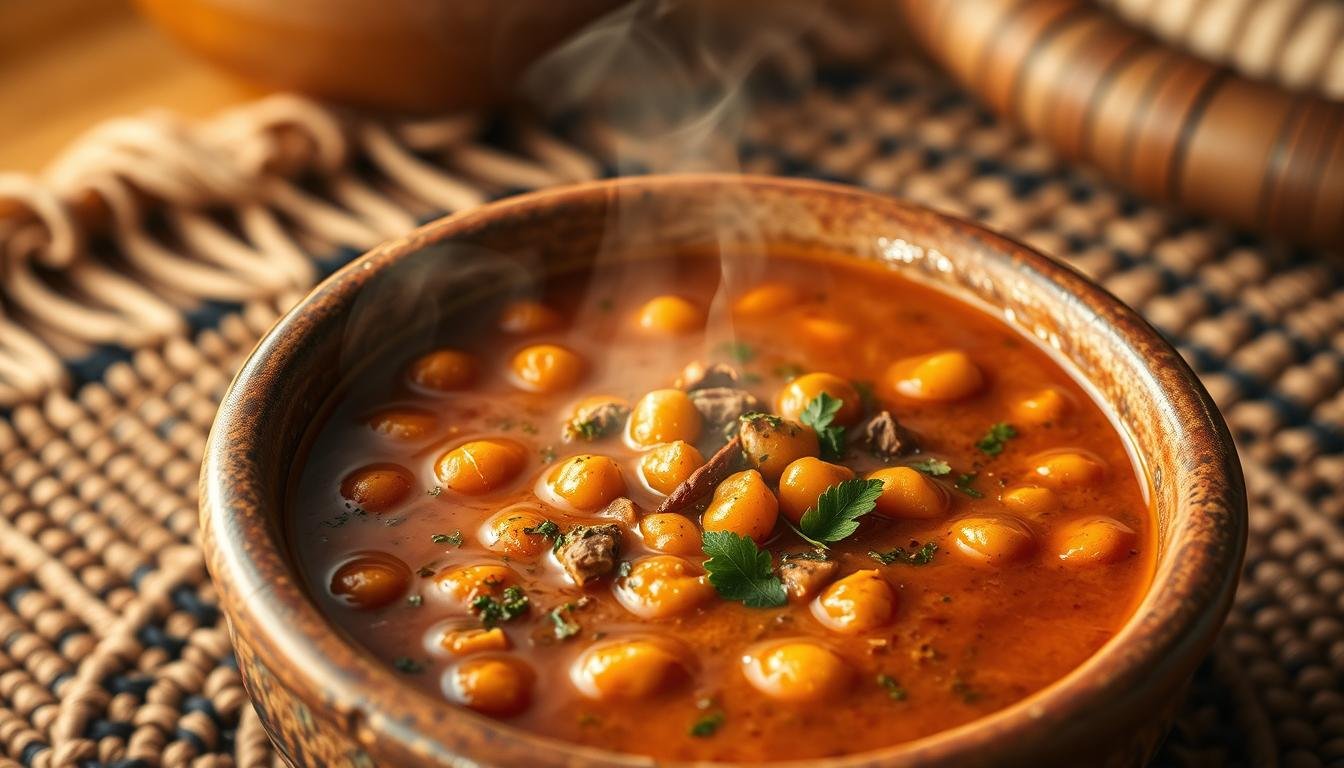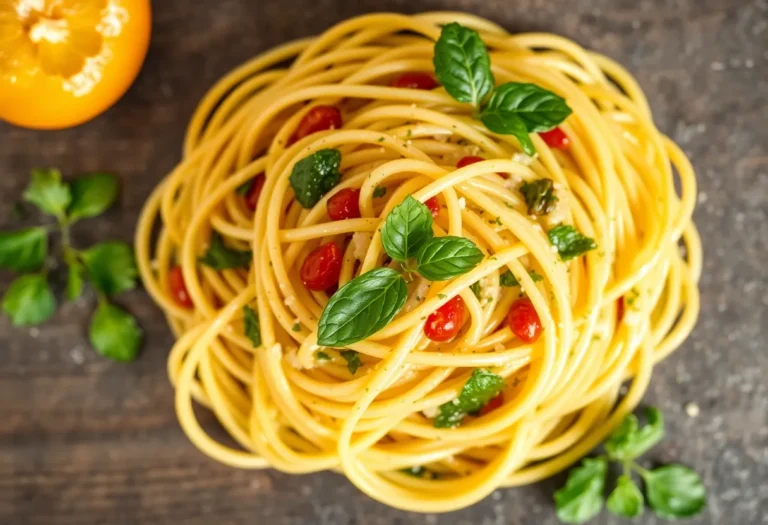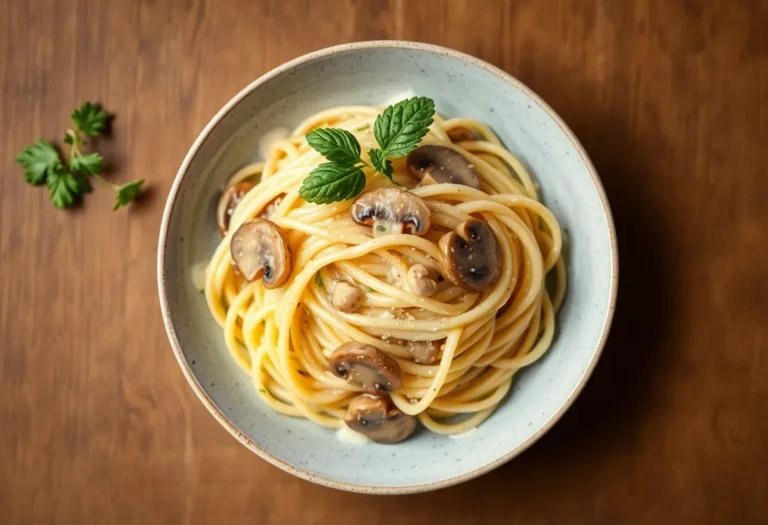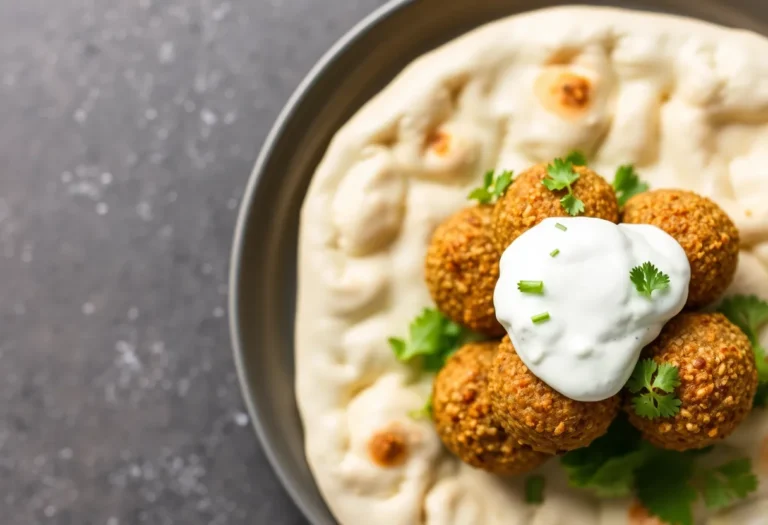Moroccan Chickpea Harira
Ever wondered about a dish that could warm your soul and take you to Morocco’s lively streets? Moroccan chickpea harira is that special soup. It’s not just a meal; it’s a journey through centuries of culinary traditions.
Picture a rich mix of chickpeas, lentils, and tender meat, all simmered with spices that share stories of North African kitchens. Harira is more than food; it’s a sign of welcome, comfort, and togetherness in Moroccan homes.
In Ramadan, this traditional dish is the star of evening meals, ending daily fasts with its delicious flavors. Its history is deeply rooted in Moroccan cuisine, linking families through a shared, comforting recipe.
Key Takeaways
- Harira is a quintessential Moroccan soup with deep cultural significance
- The soup plays a critical role during Ramadan
- It combines multiple ingredients for a nutritious meal
- Represents Moroccan culinary hospitality
- Offers a glimpse into North African food traditions
Quick Recomendation: Our blog is full of useful information to inspire you. If you are seeking a healthy way to prepare your meals, we recommend this Keto product
What is Moroccan Chickpea Harira and Its Cultural Significance
Harira is more than a soup in Moroccan cuisine. It’s a dish that shows the heart of North African flavors and traditions. During Ramadan, families in Morocco come together for this nutritious recipe. It turns a simple meal into a powerful cultural experience.
In Moroccan homes, harira is a symbol of hospitality and connection. As Ramadan’s sun sets, this rich soup is the first meal after fasting. The warm, aromatic broth brings generations together, sharing stories and traditions.
The cultural value of harira goes beyond its taste. It stands for resilience, community, and Moroccan hospitality’s warmth. Each spoonful shares a story of cooking techniques passed down through generations, making it a treasured part of North African culinary heritage.
When you taste harira, you’re not just eating a soup. You’re diving into a tradition that captures Moroccan cuisine’s essence. It’s complex, comforting, and deeply meaningful. Its nourishment for both body and soul makes it more than a simple meal.
Essential Ingredients for Authentic Harira Soup
Making a real Moroccan chickpea harira starts with the right ingredients. The quality and freshness of these ingredients are key. They add rich flavor and traditional taste to this beloved lentil soup.
Chickpeas are the main ingredient, giving the soup protein and a creamy texture. Use dried chickpeas for the best taste. Red lentils are also important, as they make the soup thick and satisfying.
Tomatoes add depth to the flavor. Choose ripe, fresh tomatoes or high-quality canned ones. Spices like cinnamon, ginger, turmeric, and paprika are essential to capture the Moroccan taste.
Adding protein like lamb or beef makes the soup more complex. But you can choose what you like. Fresh herbs like cilantro and parsley add freshness and balance out the richness.
Choosing the right ingredients can turn a simple soup into a memorable experience. It’s like taking a trip to Morocco’s lively streets.
Health Benefits of Traditional Moroccan Chickpea Harira
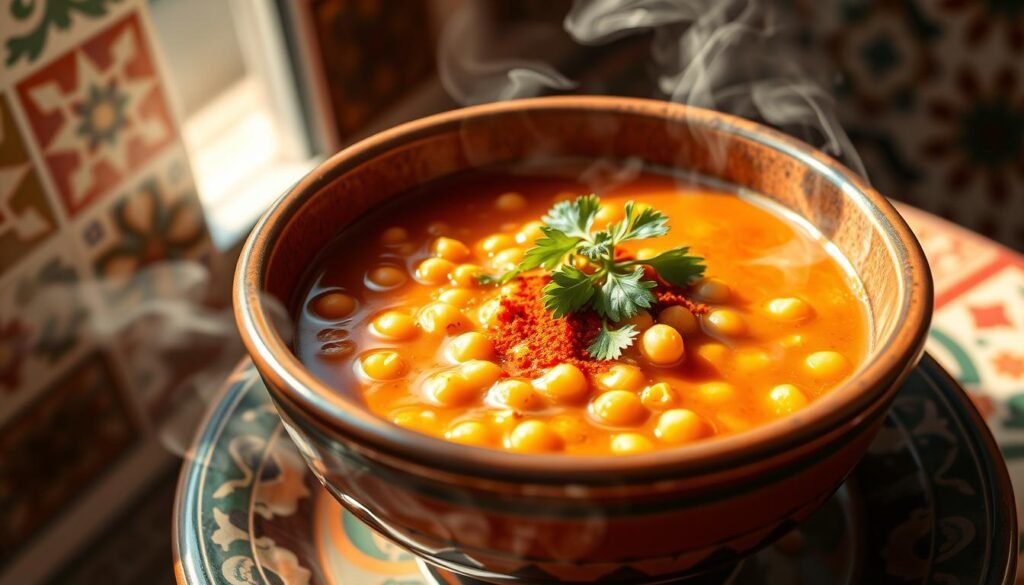
Exploring vegetarian Moroccan recipes leads to a nutritional gem: chickpea soup. Harira is more than a tasty dish; it’s a nutritional powerhouse. It’s packed with nutrients that boost your health.
Chickpeas and lentils are the heart of this soup, giving it a big protein boost. They offer about 15 grams of protein per cup. This is great for vegetarians looking to build muscle. The protein also helps keep your blood sugar stable and keeps you full.
The soup’s benefits don’t stop at protein. Chickpeas are full of dietary fiber, which is good for your digestion and can lower cholesterol. They’re also rich in iron, magnesium, and potassium. Lentils add to this by providing folate, zinc, and B-vitamins, which boost your energy.
Moroccan chickpea harira is also good for your heart. Its plant-based ingredients are full of antioxidants and anti-inflammatory compounds. Eating it regularly can help lower your risk of heart disease and support a balanced diet.
For those looking into vegetarian Moroccan recipes, harira is a tasty way to nourish your body. It combines legumes, spices, and vegetables into a meal that’s both delicious and nutritious.
Step-by-Step Preparation Guide
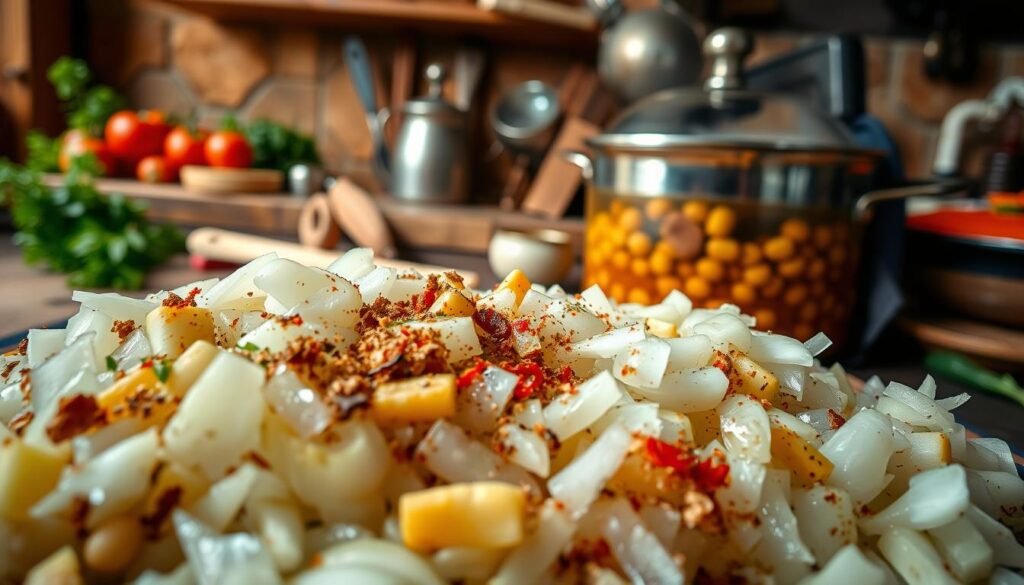
Making an authentic harira soup needs patience and care. First, collect your ingredients for this traditional Moroccan dish. You’ll need dried chickpeas, lentils, onions, tomatoes, and spices. These spices give the soup its rich taste.
Start by soaking chickpeas overnight. This makes them tender when cooked. After soaking, drain and rinse them well. Then, chop your veggies finely. This makes them blend well with the soup’s texture.
Heat olive oil in a big pot and sauté onions until they’re clear. Add spices like ginger, turmeric, and cinnamon. These spices are key to the Moroccan taste. Stir them well to avoid burning and to release their aroma.
Next, add tomatoes, chickpeas, and lentils to the pot. Pour in water or stock. Let the soup simmer slowly. This slow heat helps the flavors blend well.
As the soup cooks, it will thicken and become hearty. Stir it now and then and add more liquid if needed. Cooking time is about 60-90 minutes, depending on how thick you like it.
Mastering the Perfect Spice Blend for Harira
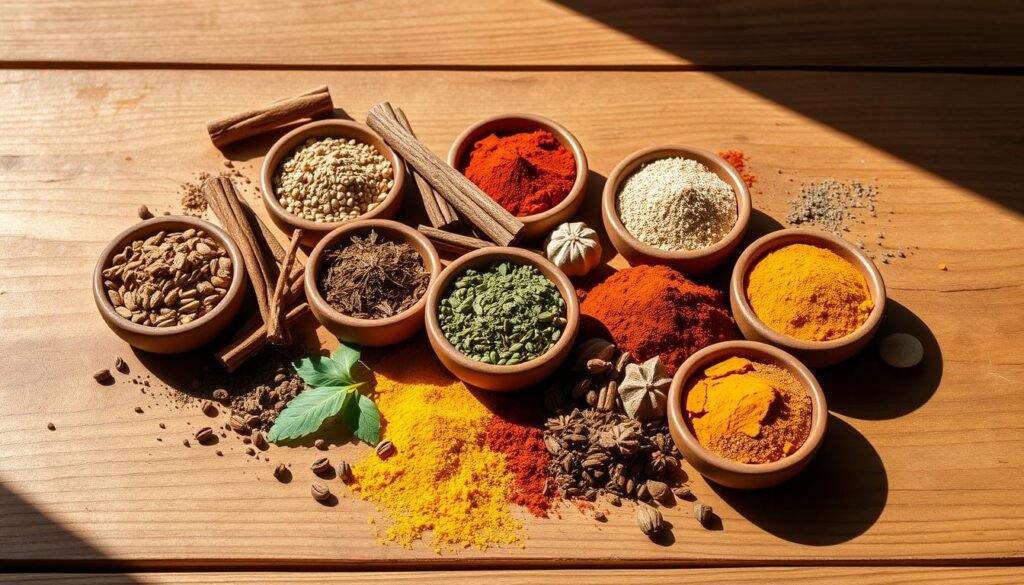
Unlocking the magic of traditional Moroccan dishes starts with understanding the spice blend. This blend is key to making moroccan chickpea harira. It’s all about creating a mix of aromatic spices that take you to North Africa.
Cumin is the base of your spice blend, giving a warm, earthy taste. Ground coriander adds a citrusy brightness. Cinnamon adds a sweet touch, while turmeric gives color and a deep, slightly bitter flavor.
To make your spice mix better, try toasting whole spices before grinding. This brings out their oils, making the flavors stronger. Heat the spices in a dry skillet for 30-60 seconds, stirring often to avoid burning. Then, grind them into a fine powder using a spice grinder or mortar and pestle.
When you make your own harira spice blend, you can adjust the flavors. Add a pinch of cayenne for heat or paprika for more depth. The aim is to balance the spices so each one complements the others. This way, every spoonful is a symphony of North African flavors.
Tips for Achieving Authentic Texture and Consistency
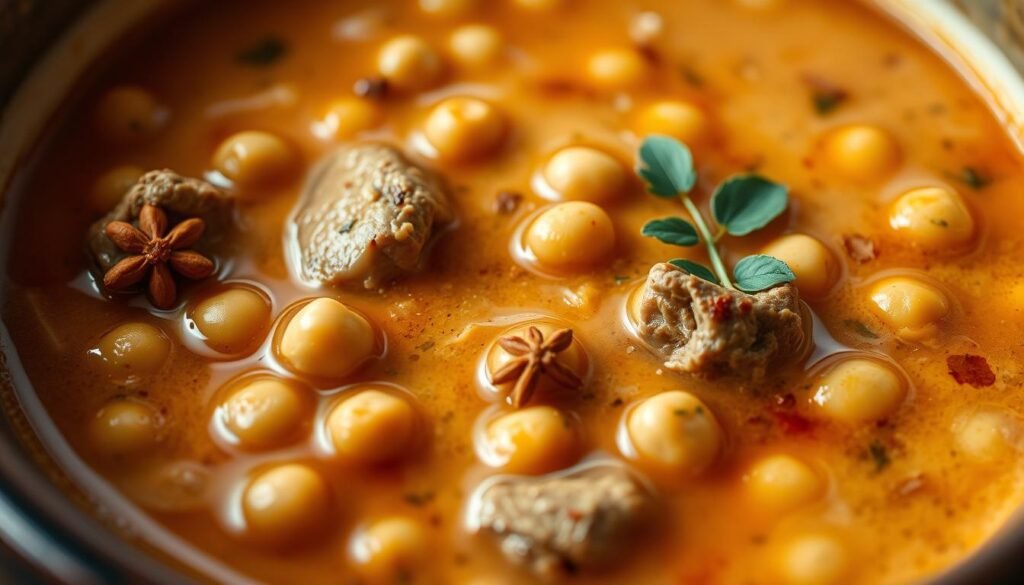
Making the perfect moroccan soup is all about the texture. Harira soup needs a balance of thickness and smoothness. It should feel warm and comforting.
Flour is key to thickening your harira. Mix chickpea or regular flour with water first. Then add it to the soup. This method avoids lumps and makes the soup silky.
Simmering is essential for the right texture. Cooking slowly helps the ingredients blend and thicken the soup. Stir now and then. If it’s too thick, add warm water slowly. If too thin, simmer uncovered to thicken.
Letting your harira rest for 10-15 minutes is a pro tip. This step makes the soup more robust. Each spoonful should be substantial but not too thick, showing the soup’s true character.
Serving Suggestions and Traditional Accompaniments
When you’re ready to serve your homemade Harira, there are many ways to make it special. Moroccan cuisine has several delightful ways to enhance your meal. During Ramadan, recipes often include special side dishes that complement the rich, hearty soup perfectly.
Start by garnishing your Harira with fresh chopped cilantro or parsley. A squeeze of lemon juice adds a bright, tangy flavor. Dates are a classic accompaniment, providing a sweet contrast to the savory broth.
Traditional Moroccan dishes often serve Harira with chebakia, a crispy honey-soaked pastry. This adds a delightful crunch to your meal. Hard-boiled eggs are another popular side that provides extra protein and texture. For a complete experience, serve the soup with fresh Moroccan bread to soak up every last drop of the flavorful broth.
Modern variations might include pairing Harira with a light salad or adding a dollop of yogurt on top. You can also experiment with different garnishes like toasted almonds or a sprinkle of extra spices. This makes the dish your own.
Remember, in Moroccan cuisine, Harira is more than just a soup. It’s a communal dish meant to be shared and enjoyed with family and friends. It’s perfect for special occasions and everyday meals alike.
Making Ahead and Storage Recommendations
Preparing moroccan chickpea harira ahead of time can save you a lot of effort. It also makes the soup taste richer. You can keep this traditional moroccan soup in the fridge for up to 4 days in a sealed container.
Freezing is a great way to keep it longer. Put the soup in freezer-safe containers, leaving some space for it to expand. Frozen, it can last up to 3 months. A tip: freeze it in portions for easy reheating.
When you reheat it, do it slowly on the stovetop. Microwaves can mess up the soup’s texture. Stir it often and add water if it gets too thick. Adding fresh herbs or a bit of lemon juice can refresh the flavors.
Legumes and spices in harira soup get even better with time. Your soup will taste amazing after a day or two in the fridge.
Common Mistakes to Avoid When Making Harira
Making the perfect chickpea soup in Moroccan cuisine needs skill and care. Many home cooks face challenges when making traditional harira. These can affect the dish’s flavor and texture.
One big mistake is overcooking lentils. They should stay slightly firm, not mushy. When making your Moroccan chickpea soup, watch the cooking time closely. Add lentils later to keep them firm and avoid a bland mix.
Seasoning is also a common mistake. Moroccan cuisine needs a fine balance of spices. Too little seasoning can make the harira taste flat. Use fresh spices and taste as you go. Cumin, turmeric, and coriander are key for depth in your soup.
Getting the right thickness is important. Too much flour or tomato paste can make the soup heavy. Start with small amounts and add more slowly to get the right consistency.
Patience is essential when making harira. Rushing can mean missing out on the flavors that develop slowly. Take your time, stir often, and let the ingredients blend naturally. You’ll get a rich, complex soup that truly represents Moroccan cuisine.
Vegetarian and Vegan Adaptations
Making vegetarian Moroccan recipes doesn’t mean losing flavor. You can turn your Moroccan chickpea harira into a tasty plant-based dish. The key is to pick protein-rich foods that keep the soup hearty.
Begin by swapping meat for protein-rich options like lentils, more chickpeas, or plant-based protein crumbles. These choices keep your soup balanced and flavorful. Adding quinoa or bulgur wheat also boosts the dish’s texture and taste.
Spices are vital in vegetarian Moroccan recipes. Use cumin, turmeric, cinnamon, and paprika to get that rich flavor. Vegetable broth is great as a base, adding deep, complex tastes like the meat version.
For extra protein, try tofu or tempeh. They soak up the spices well, making your vegan version just as good as the original.
Don’t be shy to try different plant-based proteins and make the recipe your own. Moroccan soup is all about flexibility and adapting to different diets.
Conclusion
Learning to make Moroccan chickpea harira is more than just a recipe. It connects you to North African flavors and centuries of tradition. Every spoonful brings to mind family gatherings and cultural traditions.
Making this hearty soup lets you explore a world of spices and nutritious ingredients. It’s perfect for family dinners or trying vegetarian versions. Your kitchen becomes a place to experience Moroccan hospitality.
As you get better at making harira, remember it’s an art of love and connection. The skills you learn are a bridge between cultures, bringing North African flavors to your table. Sharing this dish creates memories that last.
Your journey with Moroccan chickpea harira is just starting. Enjoy the techniques, flavors, and the joy of creating something special. It nourishes both your body and soul.
Quick Recomendation: Our blog is full of useful information to inspire you. If you are seeking a healthy way to prepare your meals, we recommend this Keto product
